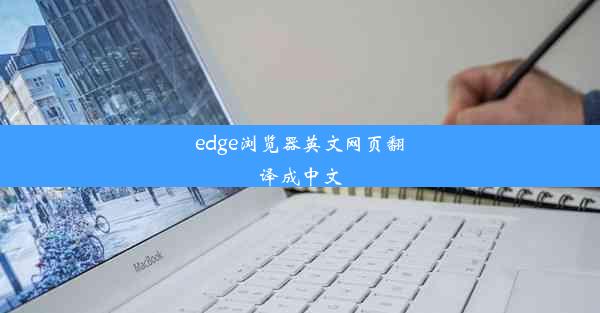edge浏览器英文网页翻译成中文
 谷歌浏览器电脑版
谷歌浏览器电脑版
硬件:Windows系统 版本:11.1.1.22 大小:9.75MB 语言:简体中文 评分: 发布:2020-02-05 更新:2024-11-08 厂商:谷歌信息技术(中国)有限公司
 谷歌浏览器安卓版
谷歌浏览器安卓版
硬件:安卓系统 版本:122.0.3.464 大小:187.94MB 厂商:Google Inc. 发布:2022-03-29 更新:2024-10-30
 谷歌浏览器苹果版
谷歌浏览器苹果版
硬件:苹果系统 版本:130.0.6723.37 大小:207.1 MB 厂商:Google LLC 发布:2020-04-03 更新:2024-06-12
跳转至官网

Introduction to Edge Browser's English to Chinese Webpage Translation
In the digital age, the ability to access information across languages is crucial. Microsoft Edge, the popular web browser, offers a feature that has become increasingly important for users worldwide: English to Chinese webpage translation. This article delves into the intricacies of this feature, providing background information and exploring various aspects that make it a valuable tool for users who navigate the web in both English and Chinese.
1. Accuracy and Reliability of Translations
Accuracy and Reliability
The accuracy of translations is paramount for users who rely on Edge's English to Chinese webpage translation feature. Microsoft has invested in advanced machine learning algorithms to ensure that the translations are as accurate as possible. This is crucial for users who need to understand technical documentation, legal documents, or scientific articles. The reliability of these translations is further enhanced by continuous updates and improvements to the translation models.
2. User Interface and Accessibility
User Interface and Accessibility
The user interface of Edge's translation feature is designed to be intuitive and accessible. Users can easily toggle between English and Chinese by clicking on the translation icon in the address bar. The interface also provides options to customize the translation settings, such as choosing the desired dialect or enabling automatic translation for new tabs. This user-friendly design ensures that even those who are not tech-savvy can benefit from the translation feature.
3. Contextual Understanding and Contextual Translations
Contextual Understanding and Contextual Translations
One of the strengths of Edge's translation feature is its ability to understand context. This is particularly important for languages like Chinese, where the meaning of a word can change significantly depending on the context. The translation engine analyzes the surrounding text to provide accurate and contextually relevant translations. This ensures that users get a more accurate understanding of the content they are reading.
4. Integration with Other Microsoft Products
Integration with Other Microsoft Products
Edge's translation feature is seamlessly integrated with other Microsoft products, such as Office and Outlook. This means that users can translate emails, documents, and presentations directly within these applications. This integration not only enhances productivity but also provides a consistent translation experience across different platforms.
5. Multilingual Support
Multilingual Support
Edge's translation feature supports a wide range of languages, not just English and Chinese. Users can translate webpages from English to Chinese and vice versa, as well as to and from other languages. This multilingual support makes Edge a versatile tool for users who frequently navigate the web in different languages.
6. Privacy and Security
Privacy and Security
Microsoft is committed to user privacy and security. The translation feature does not store user data or personal information. The translations are processed on the user's device, ensuring that sensitive information remains protected. This focus on privacy and security is a significant advantage for users who are concerned about the confidentiality of their data.
7. Performance and Speed
Performance and Speed
The translation feature in Edge is designed to be fast and efficient. The translations are generated quickly, allowing users to continue reading or working without significant delays. This performance is achieved through optimized algorithms and efficient processing, ensuring a smooth user experience.
8. Customizable Translation Settings
Customizable Translation Settings
Users have the flexibility to customize the translation settings according to their preferences. They can choose to translate entire pages, specific sections, or even individual words. This level of customization allows users to tailor the translation experience to their specific needs.
9. Offline Translation
Offline Translation
Edge offers the option to download language packs for offline translation. This feature is particularly useful for users who frequently access the web in areas with limited internet connectivity. By downloading the language packs, users can continue to translate webpages even without an internet connection.
10. Continuous Improvement and Updates
Continuous Improvement and Updates
Microsoft is continuously working to improve the translation feature in Edge. This includes regular updates to the translation models, which enhance accuracy and expand language support. Users can expect ongoing improvements that keep the translation feature up-to-date with the latest advancements in machine learning.
Conclusion
The English to Chinese webpage translation feature in Microsoft Edge is a powerful tool that enhances the accessibility and usability of the web for multilingual users. With its high accuracy, user-friendly interface, and seamless integration with other Microsoft products, Edge stands out as a leader in web browser translation features. As the digital landscape continues to evolve, the importance of such features will only grow, making Edge's translation tool a valuable asset for users worldwide.












